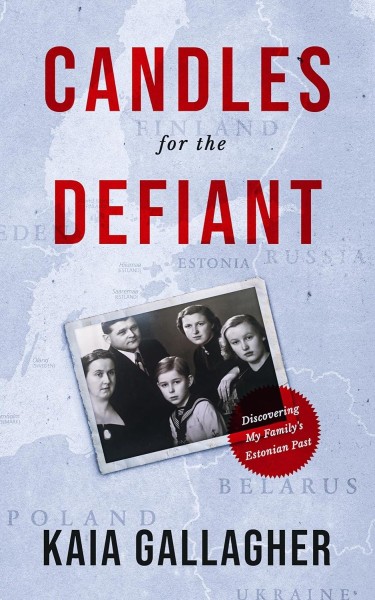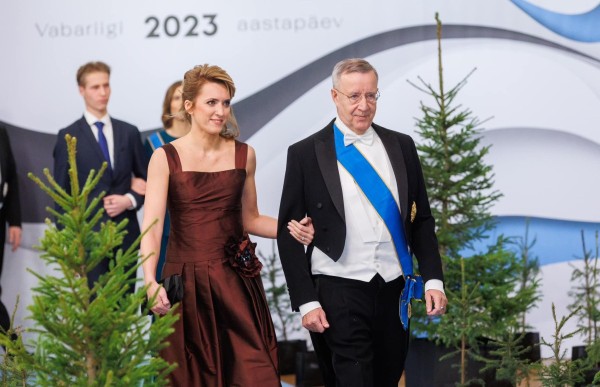A young American with Estonian roots wrote a chamber opera that tells the story of his grandmother’s tribulations in the course of the Second World War. The story begins with her early life, falling in love, marrying but then facing all that the big neighboring countries bestowed on the country of her birth, Estonia. After two occupations she had to flee to Germany with her family. There she lost her husband but survived the turmoil with her daughters. Unable to return to her home country she had to wait until she was able to immigrate to the United States and start her life anew. The composer, Lembit Beecher, tells her story through dance, music and visual imagery. The opera captures the story not as a history lesson but rather as she felt and remembered it. It draws the audience in on a human level.
The idea for the chamber opera came to Lembit Beecher in the early 2000’s as he heard her grandmother tell her story. He recorded her memories and from this he developed this documentary oratorio. Lembit is 30-year old composer/pianist/conductor and is fluent in both Estonian and English and has visited Estonia. This allowed him to tell convincingly the story of an Estonian refugee to an American audience. Lembit has degrees from the University of Michigan, Harvard and from Rice University in TX. He is currently a freelance composer living in NY.
He started to compose the music and dance for the chamber opera four years ago. He named it “And Then I Remember” adopting a phrase that his grandmother had used in a taping session. In 2010 he entered the finished product into the Opera Vista competition and was chosen as the winning entry.
Opera Vista holds this competition annually in Houston. Entries have to be original and fit a chamber opera format. The composer is required to be present during the judging and is subjected to questioning from an international panel of experts. Entries come from all over the world. This year there were entries form Sweden, Denmark, Israel and Spain to name a few. The winning composer receives a stipend and in addition Opera Vista stages the opera in the following year.
Having won the competition, Lembit’s opera was staged this year on two consecutive Saturdays in March. This was the first time the full opera was staged with Opera Vista providing professional performers. Of course, the Estonian community was mobilized for the occasion to show support for this all-Estonian work. In the course of an interview with Lembit, he expressed appreciation for this support. Both performances were well attended.
A few words about Houston. When Paul Lannus, the geography teacher of the Geislingen Estonian Gymnasium, described Texas, it was as a semi-desert prairie, inhabited only by rabbits, rattlesnakes and tumbleweed. This may be accurate for a part of Texas, but Texas has more than that: it has oil and it has harbors, which are the mainstay of Houston. These have brought wealth to the region, and with it museums, orchestras, theater and operas with high standards. These were joined half-a decade ago by Opera Vista which conducts chamber opera competitions and stagings.
However, due to its typically high temperatures Houston has not enticed many Estonians to settle here. Still, job opportunities have drawn some to work in its space exploration center, oil processing industries and the arts. Despite the small number of Estonians, Estonians have left a footprint: Tallinn Symphonic Choir under Tõnu Kaljuste has been here, the movie “Singing Revolution” was shown in a “main-street” movie theater, and in Houston’s world class ballet troupe are two Estonians. May a mention that the often-performing Scandinavian Folk Dance club of Houston starts its performances with an Estonian folk dance, the Vigala Reinlender. And now a very Estonian opera was chosen as a winner, provided with full staging for two performances and attended by packed audiences!
At the performances the audience was treated to Arvo Pärt’s “Cantus in Memory of Benjamin Britten,” setting a somber tone. It was followed by Samuel Barber’s ´Knoxville: Summer of 1915`. This piece is of a story telling nature, preparing the audience for what was to come. Then Lembit Beecher’s opera treated the audience alternatively to the different epochs in the life of his grandmother, Taimi Lepasaar: falling in love in the then independent Estonia, the entry of Soviet troops, hiding from the occupiers, the entry of German troops, escape on one of the last three ships to leave Tallinn harbor. On the way to Germany the ship was hit by a torpedo, but managed to limp on. Now followed life as a refugee, loss of her husband, the war’s end in West Germany, refugee life, and finally emigration to the United States. The dancers conveyed the mood of the events: joy, peacefulness, fright, panic, confusion, flight and sadness of loss, - and finally hope for a new life. At frequent intervals photos of the events were projected onto an overhead screen, while the audience heard in Taimi Lepasaare’s own voice her remembrances. At times she speaks with a resigned matter of fact voice as is the custom of northern people – but punctuated with joy or emotion of the happy events of her life. It is this blending of this audio with the staging that makes this chamber opera so unique.
The music composed by Lembit was varied to match the mood of the events. A very powerful moment involved the expression of anger in a story telling style that Estonians recognize as the regi-laul, with words in the Estonian language taken from the epic Kalevipoeg.
The performance was powerful especially for those in the audience who came similarly through WWII. They were drawn in deeply, and perhaps even had a hard time holding back tears. The writer of this article recalled that a photo existed taken of burning Tallinn from the same ship, named RO-22, on which Lembit’s grandmother left as the Soviet troops approached from the east. (It was the same scene that the writer of this article saw as an 11-year old.) Through several quick inquiries Aili Paal Singer, the owner of the original photo was able to provide a high-resolution copy for the opera’s second performance. This photo after all depicted a significant moment of the story.
Mr. Beecher stated that there are no definite plans to stage this important work in the immediate future but he is trying to arrange a performance in New York City and possibly Toronto next year. For this to occur support would be needed. Still, it should be desirable to get more exposure of “our story” to the American language audiences through this wonderful work. For this sponsorship would be most welcome by the composer. There is more information about the piece, including audio and video excerpts on the following website: www.lembitbeecher.com/andthen

‘And Then I Remember’, a very-Estonian chamber opera by Lembit Beecher (3)
Viimased kommentaarid
Kommentaarid on kirjutatud EWR lugejate poolt. Nende sisu ei pruugi ühtida EWR toimetuse seisukohtadega.
Suur tänu Arved et tutvustasid Lembitut ja tema muusikat. Vaatasin ja kuulasin videot ja olen rabatud.
Sounds amazing! But what makes it an opera, and not a ballet....sounds more like a dance focused thing...just curious....
I left as a 4 year old from Tallinn on a boat, 16 sep 1944. Dropped off in latvia. We walked to Berlin, arriving around Christmas time. After 6 years in DP camps, we came to America in Dec 1950. Good move.
Inimesed
TRENDING



























